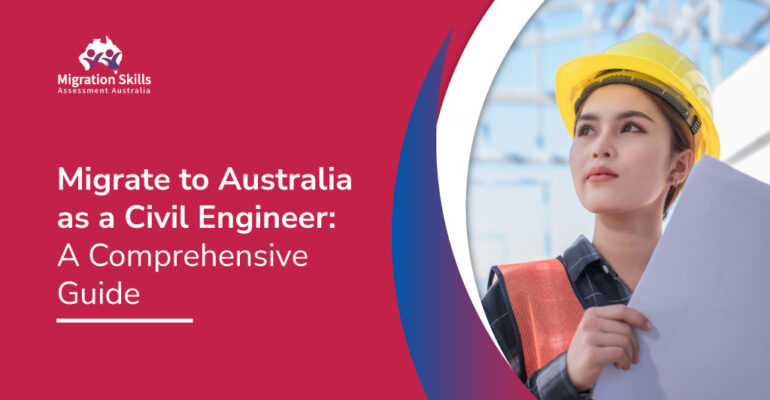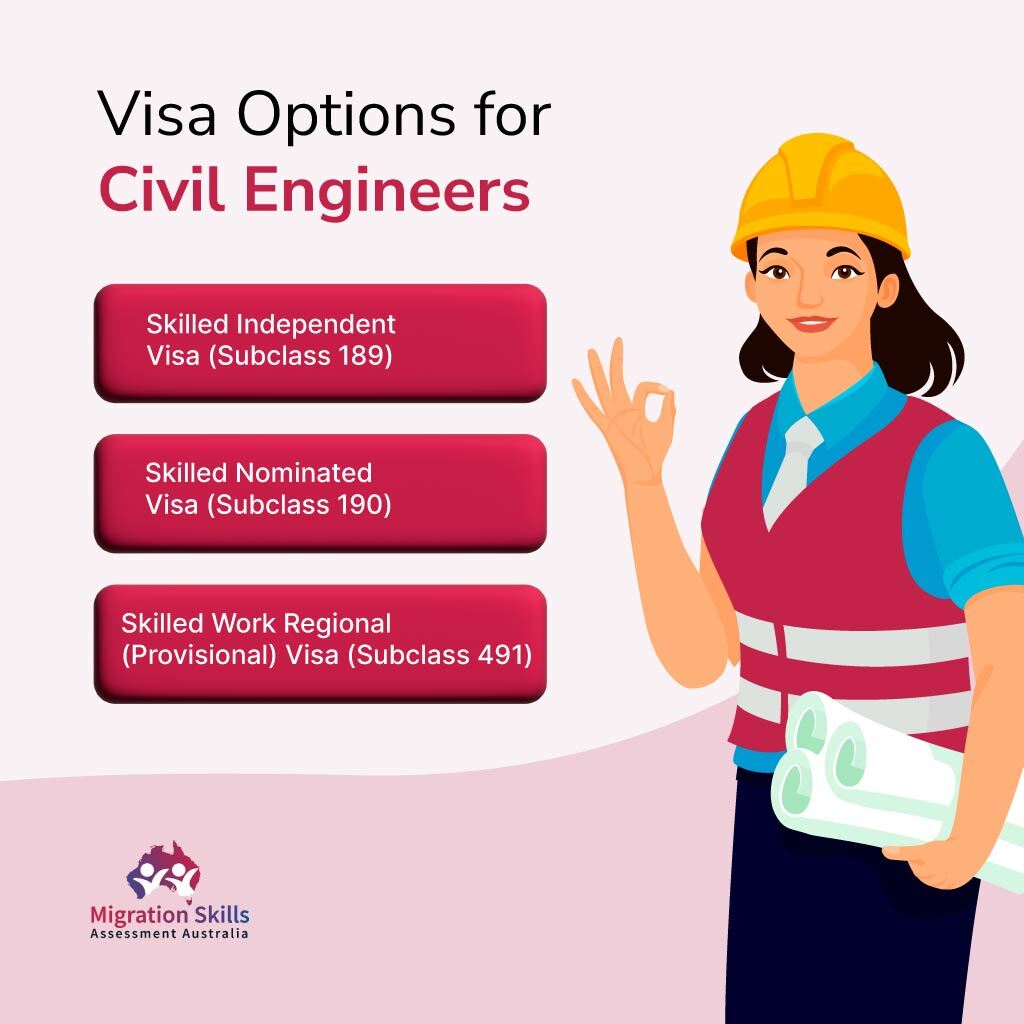Migrate to Australia as a Civil Engineer: A Comprehensive Guide

Migrate to Australia as a Civil Engineer: A Comprehensive Guide
Australia has become an attractive destination for civil engineers seeking diverse career opportunities, a thriving engineering industry, and a high standard of living. With its robust infrastructure development and urban growth, the country offers a dynamic environment for civil engineers to contribute their skills and expertise.
This comprehensive guide will provide detailed insights into the migration process, visa options, ANZSCO code, PR points calculation, professional recognition, and the step-by-step journey to migrate to Australia as a civil engineer.
Role of Civil Engineers in Australia
Civil engineers play a crucial role in Australia’s infrastructure landscape. They are mainly responsible for designing, constructing, and maintaining various projects, such as roads, bridges, buildings, water supply systems, etc.
The ANZSCO code for civil engineers is 233211, a standardized classification system used to identify and classify occupations in Australia. This code is essential for skills assessment, visa applications, and employment opportunities in the country.
Civil engineers in Australia work in various sectors, including government organizations, engineering consulting firms, construction companies, and research institutions. They contribute their expertise to large-scale infrastructure projects, urban development, environmental sustainability initiatives, and public safety.
Skills Assessment for Civil Engineers
A positive skills assessment is a prerequisite for migrating to Australia as a civil engineer. Engineers Australia, the designated assessing authority, evaluates your qualifications, work experience, and skills against Australian standards.
The skills assessment process ensures that your expertise aligns with the requirements of the Australian engineering industry. Gathering your academic transcripts, employment references, project reports, and other relevant documents to support your skills assessment application is crucial.
The skills assessment application typically involves submitting detailed information about your educational qualifications, employment history, project involvement, and professional development activities. Engineers Australia assesses the relevance and equivalence of your qualifications to Australian standards. They also evaluate your work experience to determine if it meets the required standards for a skilled migration visa.
Visa Options for Civil Engineers
Australia offers several visa options under the skilled migration program for civil engineers. These visa options allow skilled professionals to live, work, and settle in Australia based on their qualifications, skills, and experience.
Here are the main visa options for civil engineers:

1. Skilled Independent Visa (Subclass 189)
The Skilled Independent Visa (Subclass 189) is famous for civil engineers. A points-based visa allows skilled workers to live permanently and work anywhere in Australia. This visa does not require employer or state/territory government sponsorship.
To be eligible for this visa, civil engineers must meet the minimum points requirement, have a positive skills assessment from EA, and present an EOI (Expression of Interest) through the SkillSelect system.
The Subclass 189 visa is highly competitive, as it is not dependent on state or territory nominations or employer sponsorship. Applicants with higher PR points and in-demand skills have a better chance of being invited to apply for this visa.
2. Skilled Nominated Visa (Subclass 190)
The Skilled Nominated Visa (Subclass 190) is another pathway for civil engineers to migrate to Australia. This visa requires nomination by a state or territory government. Civil engineers with skills and qualifications in high demand in a specific state or territory may get nominated for this visa.
The nomination demonstrates the state or territory’s interest in your skills and enhances your chances of receiving an invitation to apply.
To get eligible for the Subclass 190 visa, civil engineers must meet the minimum points requirement, have a positive skills assessment from Engineers Australia, and receive a nomination from a participating state or territory government. Once granted, this visa allows civil engineers to live and work in the nominated state or territory permanently.
3. Skilled Work Regional (Provisional) Visa (Subclass 491)
The Skilled Work Regional Visa is a state or territory-nominated visa that allows civil engineers to live and work in designated regional areas of Australia for up to five years. This visa is a pathway to permanent residency through the Subclass 191 visa.
To get eligible for the Subclass 491 visa, civil engineers must meet the minimum points requirement, have a positive skills assessment from Engineers Australia, receive a nomination from a participating state or territory government, and commit to living and working in a regional area.
The Subclass 491 visa offers several advantages, including additional points for PR points calculation, priority in regional visas, and access to a broader range of job opportunities. It is important to note that the definition of regional areas may vary, so it is crucial to check the specific requirements of the state or territory government.
It is advisable to thoroughly research and understand the requirements and conditions of each visa subclass before making a decision. Consider factors such as desired location, long-term career prospects, and eligibility criteria when selecting the most suitable visa option.
Read more: Engineering Jobs in Australia: A comprehensive list for Skills Assessment 📑📑
PR Points Calculation for Civil Engineers:
The Points-Based System is a critical aspect of the Australian skilled migration program, determining an applicant’s eligibility for a skilled migration visa. Points are awarded based on various factors, including English language proficiency, age, educational qualifications, work experience, and other criteria.
Understanding the PR points calculation is essential for civil engineers who migrate to Australia to assess their eligibility and maximize their chances of receiving an invitation to apply for a visa.
1. Age
Age plays a significant role in the PR points calculation. The points awarded for the age get based on the applicant’s age at the time of application. The highest points (30) get awarded to applicants between 25 and 32 years old, with a gradual decrease in points for older age brackets. Applicants under 18 or over 45 are not eligible to apply for a skilled migration visa.
2. English Language Proficiency
English language proficiency is crucial in determining an applicant’s ability to settle and integrate into Australian society and the workforce. Points for English language proficiency are awarded based on the scores in recognized English language tests such as IELTS, PTE, or TOEFL. Higher scores result in more points.
For example, achieving a score of 8 or more in each of the four sections (reading, listening, writing, and speaking) of the IELTS test awards a maximum of 20 points. Lower scores, such as 7 or 6 in each component, will still yield points but at a reduced rate.
3. Educational Qualifications
Educational qualifications also contribute to the PR points calculation. Points are awarded based on the highest level of academic qualification achieved. A Bachelor’s degree in civil engineering or a related field is basically the minimum requirement for civil engineers.
A Bachelor’s degree or higher in the relevant engineering field earns a maximum of 15 points. Additional qualifications such as a Master’s or Ph.D. can provide extra points.
4. Work Experience
Work experience is a crucial factor in the PR points calculation for civil engineers. Points are awarded based on years of skilled work experience in the field. The points increase with more years of experience, up to 20 points.
For example, three years of relevant work experience earn five points, while eight or more years of experience earn a maximum of 20 points. It is important to note that the work experience should be assessed and recognized by the relevant assessing authority, such as Engineers Australia, as part of the skills assessment process.
Visit: How to make an ideal CV for a skills assessment? ✈️✈️
5. Other Factors
Additional points get obtained based on various factors, such as:
a. Regional Study
Studying in regional Australia can provide additional points. For example, completing a Bachelor’s, Master’s, or Doctorate in a regional area may earn additional five points.
b. Partner Skills
Additional points can be awarded if the applicant’s partner also possesses qualifications and skills in demand in Australia. The partner must undergo a skills assessment and meet the relevant criteria.
c. State/Territory Nomination
Some visa subclasses require state or territory government nomination. Obtaining a nomination can provide additional points, as it reflects the demand for your skills in a specific state or territory.
It is important to note that the PR points required to acquire an invitation to apply for a visa can differ depending on the specific occupation, demand, and the number of applicants in that occupation. It is advisable to aim for a higher number of points to increase your chances of receiving an invitation.
Applicants can use the SkillSelect points calculator the Department of Home Affairs provided to calculate PR points accurately. This online tool allows you to input your personal information, including age, English language proficiency scores, educational qualifications, work experience, and all other relevant details, to calculate your points score.
Read More: How to Become an Australian Permanent Resident? ✈️✈️
Achieving Professional Recognition in Australia
Professional recognition is essential for civil engineers who wish to practice in Australia. Engineers Australia, the professional body for engineers, assesses and recognizes the qualifications and competencies of engineers. Obtaining professional recognition through EA enhances employability, professional standing, and credibility within the Australian engineering industry.
To achieve professional recognition, you must apply for membership with EA and submit the required documentation, including evidence of your qualifications, work experience, and professional development activities.
Engineers Australia assesses your capabilities against the Australian engineering standards and determines if they meet the required benchmarks. They also evaluate your work experience to ensure it meets the industry’s expectations.
Steps to Migrate to Australia as a Civil Engineer:
To successfully migrate to Australia as a civil engineer, you need to follow a series of steps:
1. Research and Understand the Requirements
Conducting thorough research and understanding the requirements is crucial before migrating to Australia as a civil engineer. Familiarize yourself with the ANZSCO code, which classifies civil engineering as occupation code 233211.
This code is essential as it will get referenced throughout the migration process, from skills assessment to visa applications. Research the skills assessment process conducted by EA, the designated assessing authority for civil engineers.
Understand the required documentation, such as academic transcripts, employment references, and project reports, that need to be submitted to prove your qualifications and work experience. Additionally, gather information on English language proficiency requirements and recognized language tests such as IELTS, PTE, or OET.
2. Complete the Skills Assessment
A positive skills assessment is a prerequisite for migrating to Australia as a civil engineer. EA conducts the assessment to evaluate your qualifications, work experience, and skills against Australian standards.
Prepare your academic transcripts, employment references, project reports, and other relevant documentation to support your skills assessment application. The skills assessment application provides detailed information about your educational qualifications, employment history, project involvement, and professional development activities.
Engineers Australia assesses the relevance and equivalence of your qualifications to Australian standards. They also evaluate your work experience to determine if it meets the required standards for a skilled migration visa.
3. Meet English Language Proficiency Requirements
Proficiency in the English language is crucial for migrating to Australia as a civil engineer. You must need to the English language proficiency requirements of the Department of Home Affairs. Generally, this involves achieving the required scores in recognized English language tests like IELTS, PTE, or OET.
Prepare for the language tests by familiarizing yourself with the test format, practicing sample questions, and seeking guidance or enrolling in language preparation courses if necessary. Achieving the required scores will enhance your chances of a successful migration application.
4. Calculate PR Points
Australia’s skilled migration program operates on a points-based system, where points are awarded based on various factors to determine an applicant’s eligibility for a skilled migration visa. Calculating your PR points accurately is essential to maximize your chances of receiving an invitation to apply for a visa.
You can use the SkillSelect points calculator the Department of Home Affairs provided to calculate your PR points. This tool allows you to input your details and calculates your points score based on the information provided.
5. Choose the Right Visa
Based on your skills assessment, PR points calculation, and personal circumstances, choose the most appropriate visa subclass for your migration to Australia as a civil engineer.
a. Skilled Independent Visa (Subclass 189)
b. Skilled Nominated Visa (Subclass 190)
c. Skilled Work Regional (Provisional) Visa (Subclass 491)
When choosing the right visa subclass, consider your desired location, state/territory nomination availability, and long-term career prospects.
6. Lodge Expression of Interest (EOI)
After selecting the appropriate visa subclass, you must submit an Expression of Interest through the SkillSelect system. The EOI declares your intention to obtain a skilled migration visa as a civil engineer. Provide accurate and comprehensive information about your skills, qualifications, work experience, English language proficiency, and other relevant details.
Ensure that your EOI reflects your accurate PR points score and includes all supporting documentation required for verification. The Australian government will use the information provided in the EOI to assess your eligibility for a skilled migration visa.
7. Receive the Invitation and Apply for Visa
Once you have submitted your EOI, your profile will be visible to Australian state and territory governments and potential employers. If your profile meets their requirements and you are selected, you will obtain an invitation to apply for a visa. The invitation will specify the visa subclass and provide instructions for the application process.
Upon receiving the invitation, carefully follow the instructions and guidelines provided. Complete the visa application accurately, providing all necessary supporting documents, such as identity documents, skills assessment results, English language test results, and health and character assessments.
8. Professional Recognition
Seeking professional recognition from Engineers Australia is crucial for civil engineers intending to practice in Australia. Professional recognition enhances employability, professional standing, and credibility within the Australian engineering industry.
To achieve professional recognition, apply for membership with EA and submit the required documentation, including evidence of your qualifications, work experience, and professional development activities.
EA assesses your qualifications against the Australian engineering standards and determines if they meet the required benchmarks. They also evaluate your work experience to ensure it meets the industry’s expectations.
Start the professional recognition process as early as possible, ideally before or during the skills assessment phase. This will streamline the overall migration process and increase your chances of a successful career as a civil engineer in Australia.
9. Plan for Settlement
Once your visa gets granted, planning for your settlement in Australia is essential. Research and prepare for various aspects of your new life, including accommodation, healthcare, education for children (if applicable), transportation, and other essential services.
Consider the specific requirements of your state or territory and familiarize yourself with the local culture, laws, and regulations. Explore networking opportunities within the engineering community to establish professional connections and increase your chances of securing employment.
Read More: Skillselect Visa Categories: Which visa pathway is Right for You? ✈️✈️
Conclusion
Migrating to Australia as a civil engineer requires careful planning, thorough research, and adherence to the migration process. You can navigate the journey successfully by understanding the requirements, completing a skills assessment, meeting English language proficiency standards, calculating PR points accurately, choosing the right visa, submitting an EOI, applying for a visa, seeking professional recognition, and planning settlement.
Seek professional advice and stay updated with the latest regulations to ensure a smooth and fulfilling migration experience as a civil engineer in Australia.


